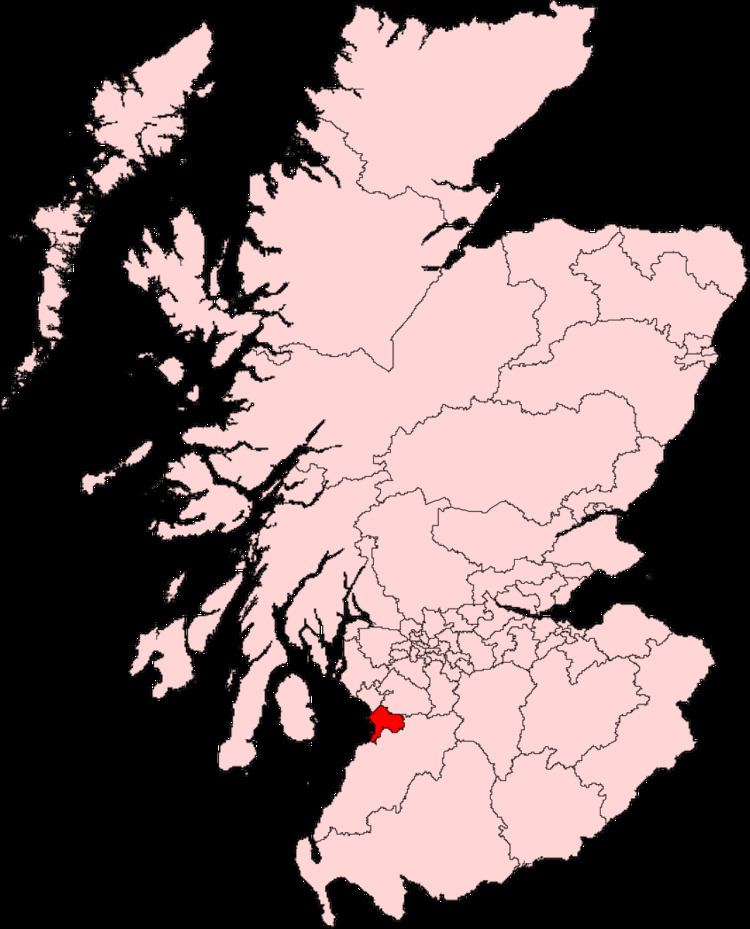Subdivisions of Scotland Ayrshire | Number of members 1 | |
 | ||
Replaced by | ||
Ayr was a county constituency of the House of Commons of the Parliament of the United Kingdom from 1950 to 2005. It elected one Member of Parliament (MP) by the first-past-the-post system of election.
Contents
Boundaries
The constituency was created by merging the Ayr burgh and Prestwick burgh components of the Ayr District of Burghs constituency with parts of the South Ayrshire and Kilmarnock constituencies.
1950 to 1974: The civil parishes of Ayr, Prestwick, Tarbolton and Symington.
1974 to 1983: The civil parishes of Ayr (except rural area around Ayr Hospital), Prestwick, Tarbolton and Symington.
1983 to 1997: The towns of Ayr (except the council estate of Kincaidston), Prestwick and Troon plus the villages of Dundonald, Loans, Monkton, Tarbolton and Symington.
1997 to 2005: The 1995 South Ayrshire electoral wards of Dundonald; East Kyle; Fort; Lochside and Craigie; Heathfield; Kingscase; Newton; Seafield; St Cuthbert's; St Nicholas; Troon Central; Troon East; Troon West; Wallacetown and Whitletts, covering Dundonald, Loans, Monkton, Prestwick, Symington, Tarbolton, Troon and the north and west of Ayr. This change led to a substantial alteration in the demographic of the constituency with the Labour Party being the prime beneficiaries.
2005 onwards: In 2005 the constituency was divided between the Central Ayrshire and Ayr, Carrick and Cumnock constituencies. This had a significant impact on the Conservative party by dividing their support in Ayr, Prestwick and Troon into two separate, predominantly Labour-voting constituencies, neither of which attained any considerable level of support for the Conservatives to match that of the Labour party. The town of Ayr joined two-thirds of the former Carrick, Cumnock and Doon Valley constituency to form Ayr, Carrick and Cumnock, with the remaining portion of the former Ayr constituency (based in Prestwick, Troon, Dundonald and Loans) joining Irvine, Annbank, Auchincruive, east Kilwinning and the remainder of Kyle to form Central Ayrshire.
At the Scottish Parliament the Ayr constituency has existed since the creation of the Scottish Parliament in 1999. The constituency retained the same boundaries as that of the former Ayr constituency at Westminster (1997-2005) until the 2011 First Periodic Review of Scottish Parliament Boundaries. The constituency is currently composed of the electoral wards of Ayr West, Ayr East, Ayr North, Prestwick and Troon, covering the towns of Ayr, Prestwick and Troon. The constituency has been represented by Conservative MSP John Scott since a by-election in 2000.
Elections in the 1980s
In 1987 Ayr became the most marginal Westminster constituency in Scotland and the fourth most marginal constituency in the United Kingdom, being won by Conservative George Younger by 182 votes.
Elections in the 1990s
In 1992 Ayr remained the most marginal constituency in Scotland and fourth most marginal constituency in the United Kingdom, being won by Conservative Phil Gallie with a majority of 85 votes.
In 1997 the boundaries of the Ayr seat were altered. Below is the notional result from the 1992 general election using the 1997 boundaries.
In 1997 Sandra Osborne became the first female MP to represent the Ayr constituency at the British Parliament, and Ayr's first ever Labour MP.
